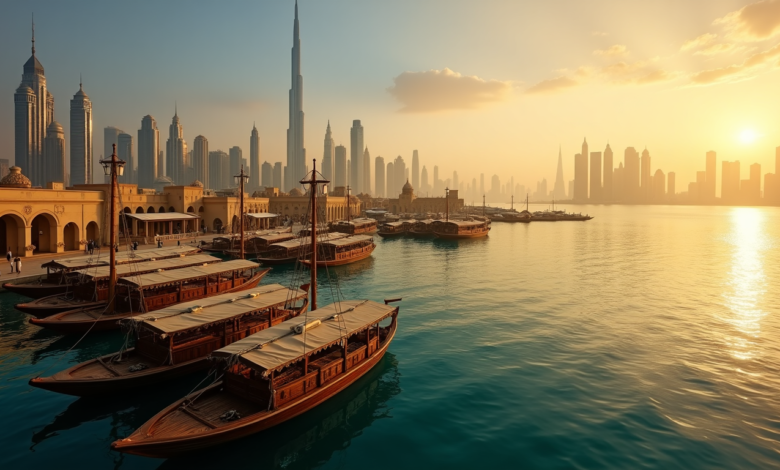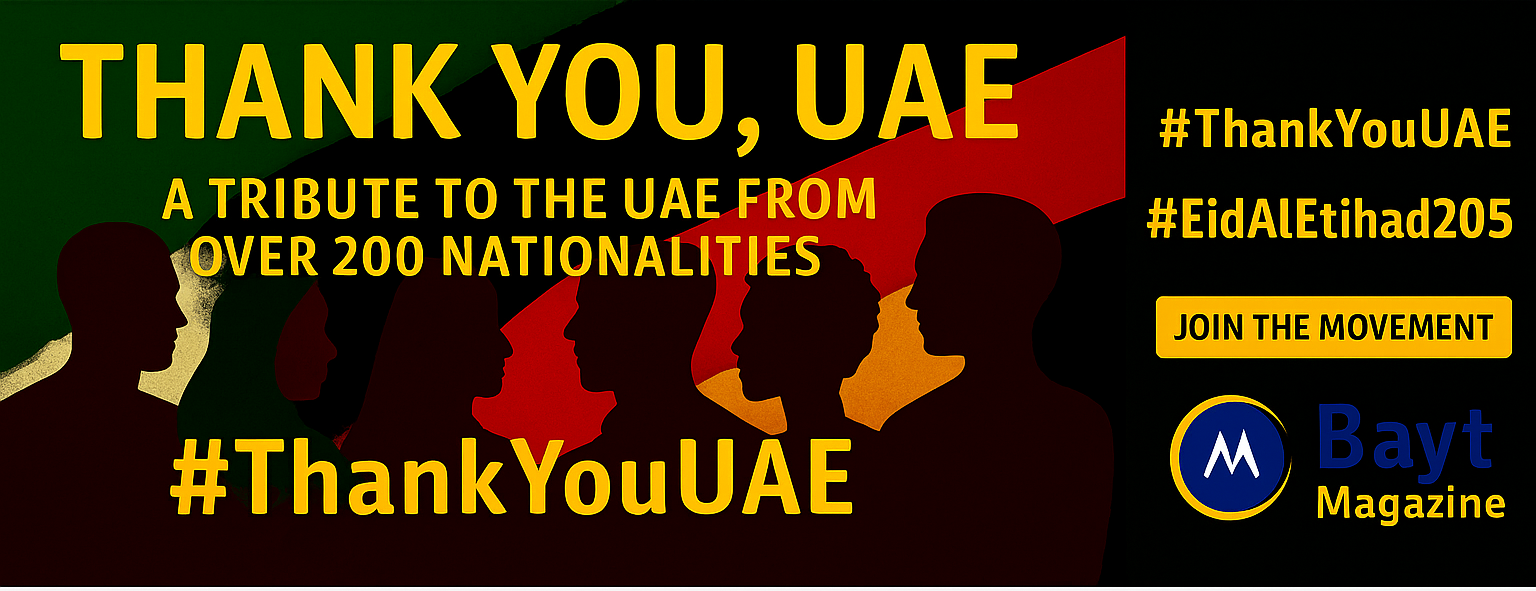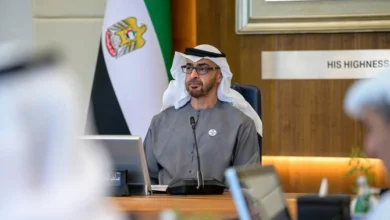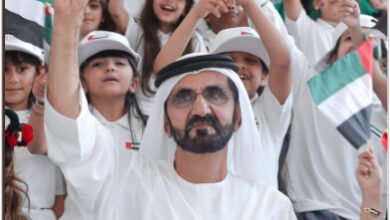
The Maktoum Family’s Journey from 1833 to Today
The Maktoum family started their remarkable trip in 1833. They turned a small settlement into one of the world’s most spectacular cities. Their first base in Dubai marked the beginning of the emirate’s rise from a pearl trading post to a global metropolis.
The family’s vision has guided Dubai’s growth in every way. Sheik Rashid bin Saeed Al Maktoum led Dubai from 1958 to 1990. His leadership brought unprecedented changes with Jebel Ali Port and Dubai International Airport. Sheik Mohammed bin Rashid Al Maktoum took charge in 2006 and expanded the economy through iconic landmarks. The Burj Khalifa and Palm Jumeirah stand tall as symbols of this progress.
One family’s steadfast dedication to progress built a city that shows what human ambition can achieve. Free trade zones emerged and World Expo 2020 came to Dubai. The Maktoums continue to shape Dubai’s destiny on the world stage.
The Birth of Modern Dubai
The Bani Yas tribe made their home deep in the Arabian desert, creating agricultural and pastoral communities in the Liwa oasis. Their strength came from close community life and marriage between families. These bonds created the foundation that would later build Dubai.
The Bani Yas tribe settlement
The Bani Yas tribe moved their base to Abu Dhabi in 1793. A major change happened in 1833 when about 800 members of the Al Bu Falasah section left for Dubai. Leadership changes in Abu Dhabi sparked this move.
Sheik Maktoum bin Butti’s vision
Sheik Maktoum bin Butti and Obeid bin Said bin Rashid led this historic move to Dubai. The settlement had 250 houses at Shindagha and the Al Fahidi Fort. Sheik Maktoum bin Butti became the only ruler after Obeid bin Said died in 1836. This started the Al Maktoum dynasty‘s lasting legacy.
Early trade developments
The settlement’s location turned out perfect. Dubai sat between two rival tribal groups – the Bani Yas to the South and the Al Qassimi to the North. The natural port near Al Fahidi Fort helped trading and pearling vessels dock safely.
The Sheik of Dubai signed the ‘General Maritime Peace Treaty’ with the British government on January 8, 1820. The settlement grew faster after Sheik Maktoum made Dubai a British protectorate through an exclusive deal in 1892. The emirate’s decision to give foreign traders complete tax freedom in 1894 helped shape Dubai into a trading hub.
Dubai became a major trading center by 1903 when a British steamship line chose it as a port of call. Merchants from different regions, especially from Lingah, built their homes in Dubai. Their presence added to Dubai’s mix of cultures.
From Pearl Trading to Global Commerce
“An easy life does not make men, nor does it build nations. Challenges make men, and it is these men who build nations.” — Sheik Mohammed bin Rashid Al Maktoum, Vice President and Prime Minister of the UAE and Ruler of Dubai
Pearl diving was Dubai’s economic backbone in the early 1900s until Japanese artificial pearls became an innovator in the industry. The Al Maktoum family saw this change and guided Dubai toward new economic opportunities.
Building the first port
Sheik Rashid bin Saeed Al Maktoum launched Dubai’s first major infrastructure project in 1959. 1972 saw the official opening of Port Rashid, which started a new era in Dubai’s maritime story. The port became a soaring win as it processed thousands of tons of construction materials and grew into an internationally recognized container terminal.
Gold souk expansion
The Dubai ruling family brought their gold trade vision to life through the Gold Souk Extension project. This development added 295 retail units and 255,000 square feet of office space in 2021. The expansion also included 468 residential units that created a complete trade environment. Many international jewelry brands made this their home, which helped Dubai earn its “City of Gold” title.
Creating free trade zones
The Al Maktoum family transformed Dubai’s economy by creating free trade zones in the 1980s. Dubai became a major re-export center, with re-exports reaching AED 157.89 billion in 2012. These free zones are a great way to get benefits for investors, such as:
- 100% foreign ownership
- Complete repatriation of capital and profits
- Zero corporate and income taxes
- Full customs duty exemption
The Dubai ruling family’s move to foreign trade in the mid-1980s made the emirate a global commerce center. The creation of specialized areas like Jebel Ali Free Zone helped Dubai become a leading international trade hub.
The Dubai Royal Family’s Vision
The Dubai royal family’s leadership continues to reshape the emirate’s landscape through ambitious infrastructure projects. The Sheik Rashid bin Saeed Corridor Improvement project covers 8 kilometers along Ras Al Khor Road and is evidence of this vision. This massive project will cut travel time from 20 minutes to 7 minutes. The project serves major development areas where 650,000 residents live.
Sheik Rashid’s infrastructure projects
The Maktoum family shows their dedication to infrastructure excellence through strategic developments. The corridor improvement project has bridges that extend 2 kilometers. Ras Al Khor Road will be widened to four lanes in each direction. These improvements will then boost the road capacity to 10,000 vehicles per hour.
Sheik Mohammed’s global ambitions
Sheik Mohammed bin Rashid Al Maktoum’s vision goes beyond physical infrastructure to social development. The Dubai Social Agenda 33 wants to double the number of Emirati families by 2033. The Dubai Family Business Management Program strengthens the emirate’s economic foundation by supporting family businesses.
The Al Maktoum family’s initiatives cover five key pillars:
- Humanitarian aid and relief
- Healthcare and disease control
- Education and knowledge
- Innovation and entrepreneurship
- Community development
These complete programs received AED 1.8 billion in 2017. This investment strategy matches Sheik Mohammed’s vision to make Dubai one of the world’s top three cities in economic influence.
Transforming Dubai’s Landscape
“The race for excellence has no finish line.” — Sheik Mohammed bin Rashid Al Maktoum, Vice President and Prime Minister of the UAE and Ruler of Dubai
The Al Maktoum family’s innovative vision has shaped Dubai’s architectural landscape. The Palm Jumeirah project expanded Dubai’s coastline by 78.6 kilometers. This massive undertaking needed 94 million cubic meters of sand and 5.5 million cubic meters of rock. The project blended trailblazing solutions with advanced engineering, such as breakwaters that protect against erosion and wave patterns.
Burj Khalifa construction
The Burj Khalifa’s construction in 2004 became a defining moment in Dubai’s growth. The tower’s construction employed 330,000 cubic meters of concrete and 55,000 tons of steel rebar. The building’s design includes pressurized, air-conditioned refuge floors at every 13 levels to ensure safety.
Dubai Marina planning
Dubai Marina emerged as a vibrant waterfront community in the early 2000s. The area grew into an integrated urban hub that combines residential towers, commercial spaces, and recreational facilities. We designed this marina to house tens of thousands of residents while offering world-class amenities and panoramic views.
Future architectural projects
The Dubai ruling family continues to drive the emirate’s growth through bold projects:
- The Palm Jebel Ali development will create seven connected islands along 110 kilometers of shoreline to house 35,000 families
- Dubai Creek Tower’s redesign and relaunch will begin construction in 2024
- The AED 120 billion Al-Maktoum International airport expansion will serve 255 million passengers annually by 2050
These developments are the foundations of Dubai’s 2040 Urban Master Plan, which wants to make the emirate the world’s best city to live in.
The Al Maktoum family has changed Dubai from a modest pearl trading settlement into a global metropolis through nearly two centuries of visionary leadership. Their remarkable trip began with Sheik Maktoum bin Butti’s leadership in 1833. His bold decisions and careful planning helped reshape the nation’s destiny.
Dubai’s rise under the Al Maktoum dynasty shows their innovative approach to development. The city has become a leading global destination through free trade zones, iconic structures like Burj Khalifa, and ambitious projects such as Palm Jumeirah.
The ruling family’s steadfast dedication to excellence shapes Dubai’s future through the 2040 Urban Master Plan and major infrastructure projects. Dubai maintains its position as a city that perfectly balances modernity with tradition, commerce with culture, and ambition with sustainability through social initiatives and economic diversification strategies.
The Al Maktoum family’s golden story inspires others about how leadership, vision, and determination can turn dreams into reality. Their legacy shows that true success comes from building communities and creating opportunities for future generations, not just from constructing buildings.




